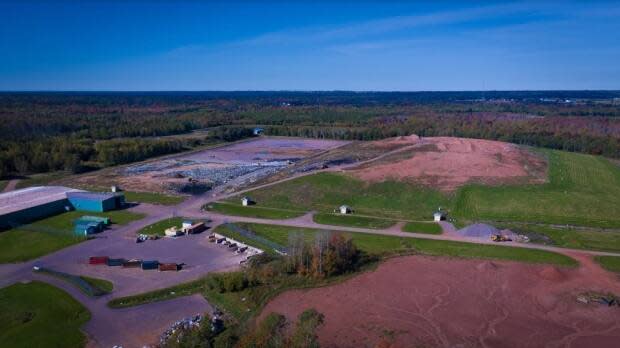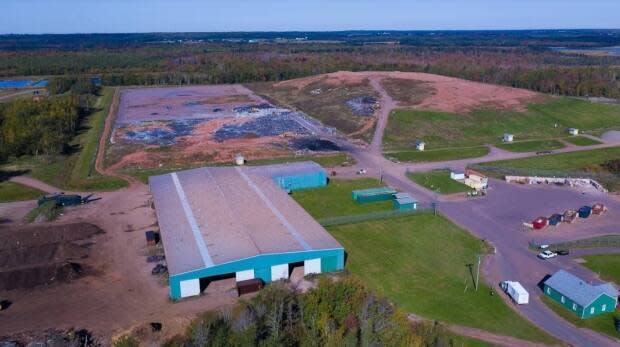12 things you always wanted to know about P.E.I.'s only landfill, but were afraid to ask

When you're sorting your waste from your compost and recyclables, do you ever think about where the waste in your black cart ends up?
How big is Prince Edward Island's landfill, and how soon before it's full? What happens then?
We have the answers to everything you ever wanted to know about the Island's only landfill, where your black cart waste may end up.
CBC talked with Heather Myers, disposal manager for Island Waste Management, and Elizabeth Mallett, who supervises the East Prince Waste Management Facility, which includes the landfill as well as a small compost facility and drop-off centre.
Where is it?
Since late 1994, P.E.I.'s only landfill has been off Highway 2 in Wellington, about 15 kilometres west of Summerside.

Before that there were more than 60 provincial and municipal dumps across P.E.I., which have now closed, Mallett said.
The facility offers tours — just call ahead.
How big is it?
The landfill is about 13 hectares.
Three of six cells are full, two are almost full, and the final one is almost empty.
The finished height of the trash heap is 35 metres above sea level.
When will it be full?
"At the present rate that we're filling the landfill, which is at about 24,500 cubic metres a year, we should have space for about another 30 years," Myers says.
Myers said there is room for one more small cell on the site.
IWMC owns more land just to the west of the present facility, which could be a potential location for another similar-size landfill, although approvals have neither been sought nor given for an expansion. That could add another 50 years or so to the life of the landfill site.
So, the Wellington landfill could have another 80 years of life.
"The less amount of land we're using up for a landfill, the better," Myers said. "That's why it's important for people to sort properly."
IWMC continues to seek programs to reduce what goes into the landfill, like agricultural plastics and electronics like toasters and fans.
Myers said a program a couple of years ago to divert mattresses from the landfill to a Quebec recycler has taken about 14,000 mattresses or box springs a year out of the landfill. Islanders can drop off their old mattresses for free, while businesses like hotels must pay fees.
Will that trash ever break down?
No.
Landfills are designed to be deprived of oxygen, or anaerobic. Oxygen helps things break down — those are aerobic conditions.
"Five hundred-plus years, maybe never," is how long it could take trash to break down, Myers said, noting people have removed newspapers after 50 years a landfill and they were still legible.
Aerobic conditions can create potent greenhouses gases such as methane, which is another reason IWMC wants to keep organic matter out of the landfill.
What garbage goes there?
Did you know only the waste from Prince County goes into the landfill?

Trash from Kings and Queens counties is burned at the Energy From Waste incinerator in Charlottetown, which provides heat to public buildings.
Myers said people frequently ask why they need to separate their garbage if it just going to be burned.
"They can only take so much material a year, it's around 26,000 metric tonnes," Myers said. "If people aren't sorting correctly and putting organics and recyclables into their waste cart, then that capacity gets used up much quicker at P.E.I. Energy Systems, which then diverts it to landfill."
Also, not everything incinerates, including glass bottles and tin cans, she said.
Non-toxic "bottom ash" from the incinerator is actually trucked to Wellington to be spread as over trash at the landfill after it has been compacted — nothing goes to waste during this process!
How close is the landfill to homes?
The active area of the landfill must be at least 750 metres away from the nearest homes or businesses. The closest homes are on the St. Nicholas Road, Myers said.
Neighbours do not have any complaints about the site, Mallett added.
Is it like a dump?
"The landfill cell is not like a landfill that was on P.E.I. many years ago — it's what's called an engineered landfill cell," Myers said. There are many base layers to protect the ground and groundwater from contamination, including compacted soil, gravel for drainage, layers of protective matting and a thick high-density polyethylene liner. That liner comes in huge rolls rolled out over the entire landfill, and the seams are fused together to prevent leaks.

"We end up with basically a big bathtub," Myers said.
The trash that is dropped off by commercial haulers and businesses is compacted by a 37-tonne, $700,000 landfill compacting machine, that basically runs over and flattens garbage all day.
Rain or melting snow that falls onto the garbage is drained through pipes in the base layers — Myers said it's "like a tea bag" — then pumped to holding ponds on the site to be treated to meet environmental standards.
Also unlike dumps of old, the landfill is surrounded by groundwater monitoring wells that are checked annually for possible contamination of nearby groundwater.
The cells of the landfill that are full are "capped" with layers of sand, plastic, gravel and topsoil, then planted with grass.
What goes in the landfill?
Less and less goes into the landfill, Myers said, as IWMC starts or joins programs that remove household electronics, light bulbs, paints, tires and agricultural waste like baler twine and silage wrap.

Mattresses used to go in the landfill but were bulky and impossible to compact. A couple of years ago, IWMC became part of a recycling program that sends the mattresses to Quebec. IWMC gets about 14,000 mattresses or box springs every year, so that alone is a huge diversion from the landfill.
Islanders are doing a "reasonable job" sorting but there's still plenty of room for improvement, Myers said.
"A lot of recyclables end up in the waste stream, even refundables like water bottles," Myers said. She speculates that could be because it takes some effort to wash recyclables and store them.
Although more take-out cups and cutlery are made from compostable materials like corn, Myers notes many of them still look like plastic and make it difficult for IWMC staff to discern what's what, especially since the markings on the items are small and sometimes dirty. She'd like to see Islanders choose items that do not resemble plastics.
If you sort properly, "it is a good feeling to know that you are generating such little waste," she added. "It's something you can take pride in."
People don't dump as much as they used to
Islanders put 50 to 65 per cent less waste in than before P.E.I. began the Waste Watch program began.
"But we can always do better," Myers said. People (she includes herself) purchase things they don't need, or that have excessive packaging.
Seek out items of higher quality so you generate less waste replacing them, she said, and buy in bulk to reduce packaging.
"Even if we all started with one little thing, that is better than us all doing nothing."
There's an app for that!
Besides newsletters a couple of times a year in the mail, a frequently updated website and a toll-free phone number, did you know IWMC has a free mobile app called Recycle Coach to help you with dates, times and sorting questions?
It will send you reminders to put your black or green cart curbside, and can be especially helpful during holidays when carts may be picked up on alternate days.
Does the landfill make money?
The landfill charges disposal fees to cover its costs, Myers said, but it does not make a profit.
Dumping commercial waste from businesses and institutions costs $100 a tonne.
Did COVID-19 have an impact?
Prior to COVID-19, IWMC was breaking even, Myers said. But since the pandemic began in March 2020, businesses have been dumping much less, while households have been disposing of much more.
People working and staying home during the pandemic took the opportunity to purge and redecorate, and put their waste curbside. IWMC pocketed no additional fees from them. But businesses dumped much less, and IWMC lost out on those fees.
"We were down 20 to 25 per cent for the commercial [by weight], and we were up by the residential by about the same ... but we don't get any extra fees for the residential."
Even though the trash evened out, the money didn't, Myers said. However, that is now beginning to turn around.
"Things are recovering," Myers said.

